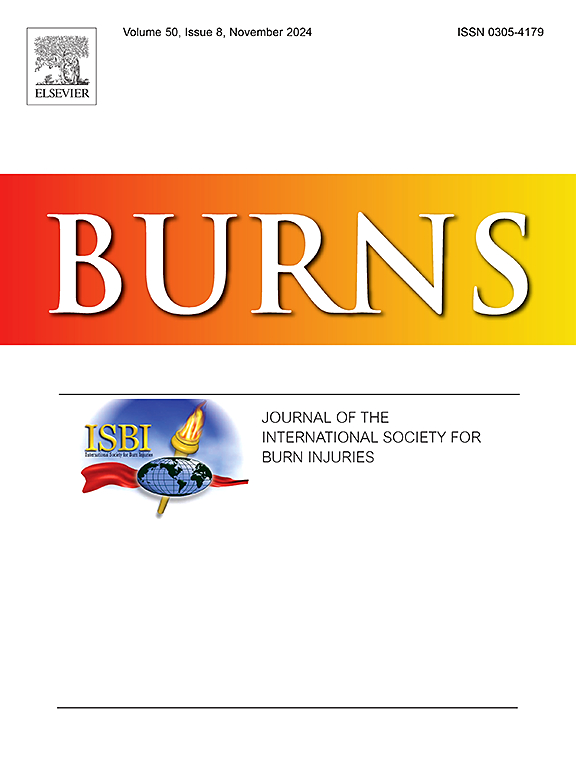In vivo evaluation of bioactive glass-reinforced multifunctional composite hydrogel for thermal burn and chronic diabetic wound repair
IF 2.9
3区 医学
Q2 CRITICAL CARE MEDICINE
引用次数: 0
Abstract
Background
Thermal burn injuries and chronic diabetic wounds pose a vast array of pathophysiological problems (low angiogenicity, persistent inflammation, bacterial infection, tissue necrosis) that contribute to delayed healing and poor regeneration as compared to normal wounds. Multifunctional hydrogels have recently gained immense popularity and become viable choices for chronic wound management because of their versatile functionality, like tunable properties, high biocompatibility, soft and moist microenvironment and mimicking natural tissue surrounding properties.
Methods
We first fabricated a multifunctional composite hydrogel (MCH) consisting of 5 % gelatin, 1 % chitosan, 100 ng/ml Cur-capped silver nanoparticles, and 1.5 % PDA-coated bioactive glass and evaluated its wound healing potential in burn and chronic diabetic wounds in BALB/c mice. The reduction in wound area was assessed at various time intervals. Also, structural changes and cellular responses were evaluated using H & E staining and Masson Trichrome staining. The gene expression of VEGFA, COL1A1, IL-6, IL-10, and TGF-β1 was evaluated using RT-PCR of tissue samples extracted from the healed area.
Results
The in vivo wound healing assessment in thermal burn wounds and diabetic wounds showed a significant reduction in wound area (up to 87 % and 80 % respectively) on day 14 in the wounds treated with MCH. These histological and molecular studies confirmed that the presence of bioactive glass in MCH aids in the polarization of macrophages from M1 to M2 phenotype, released Si ions induce blood vessel formation, and collagen deposition and the presence of Cur-AgNPs effectively reduces inflammation and induces collagen deposition in treated groups as compared to control groups.
Conclusion
The incorporation of PDA-coated BG endows the adhesivity and angiogenic and Cur-AgNPs provided antibacterial and anti-inflammatory/antioxidative propertied to hydrogel, to regulate the wound microenvironment at cellular and molecular levels render a vital paradigm to facilitate and accelerate the repair and regeneration of burn and chronic diabetic wounds.
生物活性玻璃增强多功能复合水凝胶用于热烧伤和慢性糖尿病创面修复的体内评价
研究背景:与正常伤口相比,热烧伤和慢性糖尿病伤口会引起一系列病理生理问题(血管生成性低、持续炎症、细菌感染、组织坏死),导致愈合延迟和再生不良。多功能水凝胶最近获得了巨大的普及,并成为慢性伤口管理的可行选择,因为它们具有多种功能,如可调的特性,高生物相容性,柔软湿润的微环境和模仿自然组织周围的特性。方法首先制备由5 %明胶、1 %壳聚糖、100 ng/ml铜包覆银纳米粒子和1.5 %聚乳酸包覆生物活性玻璃组成的多功能复合水凝胶(MCH),并评价其在BALB/c小鼠烧伤和慢性糖尿病创面的愈合潜力。在不同的时间间隔评估伤口面积的减少。同时,用H &; E染色和马松三色染色评价结构变化和细胞反应。采用RT-PCR方法检测愈合部位组织样本中VEGFA、COL1A1、IL-6、IL-10、TGF-β1的基因表达。结果对热烧伤创面和糖尿病创面的体内愈合评估显示,MCH治疗创面第14天创面面积显著减少(分别为87% %和80% %)。这些组织学和分子研究证实,与对照组相比,MCH中生物活性玻璃的存在有助于巨噬细胞从M1表型向M2表型极化,释放的Si离子诱导血管形成,胶原沉积和cu - agnps的存在有效地减轻了炎症并诱导胶原沉积。结论聚乳酸包被的BG具有粘附性和血管生成性,而cu - agnps具有水凝胶的抗菌和抗炎/抗氧化特性,在细胞和分子水平上调控创面微环境,为促进和加速烧伤和慢性糖尿病创面的修复和再生提供了重要的模式。
本文章由计算机程序翻译,如有差异,请以英文原文为准。
求助全文
约1分钟内获得全文
求助全文
来源期刊

Burns
医学-皮肤病学
CiteScore
4.50
自引率
18.50%
发文量
304
审稿时长
72 days
期刊介绍:
Burns aims to foster the exchange of information among all engaged in preventing and treating the effects of burns. The journal focuses on clinical, scientific and social aspects of these injuries and covers the prevention of the injury, the epidemiology of such injuries and all aspects of treatment including development of new techniques and technologies and verification of existing ones. Regular features include clinical and scientific papers, state of the art reviews and descriptions of burn-care in practice.
Topics covered by Burns include: the effects of smoke on man and animals, their tissues and cells; the responses to and treatment of patients and animals with chemical injuries to the skin; the biological and clinical effects of cold injuries; surgical techniques which are, or may be relevant to the treatment of burned patients during the acute or reconstructive phase following injury; well controlled laboratory studies of the effectiveness of anti-microbial agents on infection and new materials on scarring and healing; inflammatory responses to injury, effectiveness of related agents and other compounds used to modify the physiological and cellular responses to the injury; experimental studies of burns and the outcome of burn wound healing; regenerative medicine concerning the skin.
 求助内容:
求助内容: 应助结果提醒方式:
应助结果提醒方式:


